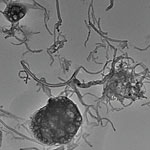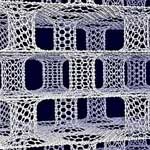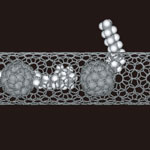Showing Spotlights 185 - 192 of 318 in category All (newest first):
 The toxicity issues surrounding carbon nanotubes (CNTs) are highly relevant for two reasons: Firstly, as more and more products containing CNTs come to market, there is a chance that free CNTs get released during their life cycles, most likely during production or disposal, and find their way through the environment into the body. Secondly, and much more pertinent with regard to potential health risks, is the use of CNTs in biological and medical settings. CNTs interesting structural, chemical, electrical, and optical properties are explored by numerous nanomedicine research groups around the world with the goal of drastically improving performance and efficacy of biological detection, imaging, and therapy applications. In many of these envisaged applications, CNTs would be deliberately injected or implanted in the body. While it has been shown that carbon nanotubes can indeed act as a means for drug delivery, negative effects such as unusual and robust inflammatory response, oxidative stress and formation of free radicals, and the accumulation of peroxidative products have also been found as a result of carbon nanotubes and their accumulated aggregates. As a possible solution, scientists have provided compelling evidence of the biodegradation of carbon nanotubes by horseradish peroxidase and hydrogen peroxide over the period of several weeks. This marks a promising possibility for nanotubes to be degraded by horseradish peroxidase in environmentally relevant settings.
The toxicity issues surrounding carbon nanotubes (CNTs) are highly relevant for two reasons: Firstly, as more and more products containing CNTs come to market, there is a chance that free CNTs get released during their life cycles, most likely during production or disposal, and find their way through the environment into the body. Secondly, and much more pertinent with regard to potential health risks, is the use of CNTs in biological and medical settings. CNTs interesting structural, chemical, electrical, and optical properties are explored by numerous nanomedicine research groups around the world with the goal of drastically improving performance and efficacy of biological detection, imaging, and therapy applications. In many of these envisaged applications, CNTs would be deliberately injected or implanted in the body. While it has been shown that carbon nanotubes can indeed act as a means for drug delivery, negative effects such as unusual and robust inflammatory response, oxidative stress and formation of free radicals, and the accumulation of peroxidative products have also been found as a result of carbon nanotubes and their accumulated aggregates. As a possible solution, scientists have provided compelling evidence of the biodegradation of carbon nanotubes by horseradish peroxidase and hydrogen peroxide over the period of several weeks. This marks a promising possibility for nanotubes to be degraded by horseradish peroxidase in environmentally relevant settings.
Nov 10th, 2008
 Forget boxy loudspeakers. Researchers have now found that just a piece of carbon nanotube thin film could be a practical magnet-free loudspeaker simply by applying an audio frequency current through it. These loudspeakers - which are only tens of nanometers thick, transparent, flexible, and stretchable - can be tailored into many shapes and mounted on a variety of insulating surfaces, such as room walls, ceilings, pillars, windows, flags, and clothes without area limitations. The scientists demonstrated that their CNT loudspeakers can generate sound with wide frequency range, high sound pressure level, and low total harmonic distortion. Another advantage compared to conventional loudspeakers is that the CNT loudspeakers don't vibrate and are damage tolerant. They will work even if part of the thin film is torn or damaged.
Forget boxy loudspeakers. Researchers have now found that just a piece of carbon nanotube thin film could be a practical magnet-free loudspeaker simply by applying an audio frequency current through it. These loudspeakers - which are only tens of nanometers thick, transparent, flexible, and stretchable - can be tailored into many shapes and mounted on a variety of insulating surfaces, such as room walls, ceilings, pillars, windows, flags, and clothes without area limitations. The scientists demonstrated that their CNT loudspeakers can generate sound with wide frequency range, high sound pressure level, and low total harmonic distortion. Another advantage compared to conventional loudspeakers is that the CNT loudspeakers don't vibrate and are damage tolerant. They will work even if part of the thin film is torn or damaged.
Nov 3rd, 2008
 While individual carbon nanotubes could find applications in nanoelectronics, in order to exploit their intriguing properties on the macroscale, for instance in thin films and membranes, many trillions of these tubes must be assembled. These macroscopic aggregates are commonly called buckypapers - thin sheets made from intertwined carbon nanotubes. Buckypapers could find numerous applications: As one of the most thermally conductive materials known, buckypaper could lead to the development of more efficient heat sinks for chips; a more energy-efficient and lighter background illumination material for displays; a protective material for electronic circuits from electromagnetic interference due to its unusually high current-carrying capacity; or switchable surfaces. Borrowing a technology from the textile industry, researchers have developed a novel nanotechnology fabrication technique that results in high-quality CNT membranes with controllable thickness and topology at high-speed and low-cost for many practical applications.
While individual carbon nanotubes could find applications in nanoelectronics, in order to exploit their intriguing properties on the macroscale, for instance in thin films and membranes, many trillions of these tubes must be assembled. These macroscopic aggregates are commonly called buckypapers - thin sheets made from intertwined carbon nanotubes. Buckypapers could find numerous applications: As one of the most thermally conductive materials known, buckypaper could lead to the development of more efficient heat sinks for chips; a more energy-efficient and lighter background illumination material for displays; a protective material for electronic circuits from electromagnetic interference due to its unusually high current-carrying capacity; or switchable surfaces. Borrowing a technology from the textile industry, researchers have developed a novel nanotechnology fabrication technique that results in high-quality CNT membranes with controllable thickness and topology at high-speed and low-cost for many practical applications.
Oct 15th, 2008
 In contrast to the often depicted model of a perfect hexagonal lattice cylinder shape of carbon nanotubes, these nanomaterials often become twisted, bent or otherwise deformed during their growth, processing, or characterization. Researchers have found that some of these defects can be associated with a rearrangement of atoms and bonds which in turn will impact on the band structure and therefore affects the electronic properties of the tube. Previous experimental Atomic Force Microscopy and Transmission Electron Microscopy studies of carbon nanotubes have clearly identified their susceptibility to collapse and theoretical predictions of the impact that these deformations have on the electronic properties have been formulated. Experiments at the University of Surrey in the UK are the first to show atomically resolved radially collapsed double-walled carbon nanotubes, bringing also clear evidence of changes in the fundamental electronic behavior of these systems in response to the deformation.
In contrast to the often depicted model of a perfect hexagonal lattice cylinder shape of carbon nanotubes, these nanomaterials often become twisted, bent or otherwise deformed during their growth, processing, or characterization. Researchers have found that some of these defects can be associated with a rearrangement of atoms and bonds which in turn will impact on the band structure and therefore affects the electronic properties of the tube. Previous experimental Atomic Force Microscopy and Transmission Electron Microscopy studies of carbon nanotubes have clearly identified their susceptibility to collapse and theoretical predictions of the impact that these deformations have on the electronic properties have been formulated. Experiments at the University of Surrey in the UK are the first to show atomically resolved radially collapsed double-walled carbon nanotubes, bringing also clear evidence of changes in the fundamental electronic behavior of these systems in response to the deformation.
Oct 9th, 2008
 Safe, efficient and compact hydrogen storage is a major challenge in order to realize hydrogen powered transport. According to the U.S. Department of Energy Freedom CAR program roadmap, the on-board hydrogen storage system should provide 6 weight % of hydrogen capacity at room temperature to be considered for technological implementation. We have written several Nanowerk Spotlights where we introdduced and described novel, nanotechnology-based concepts for economically viable hydrogen storage methods. Scientists consider the storage of hydrogen in the absorbed form as the most appropriate way to solve the storage problem and one particular group of materials they have focused on are carbon nanomaterials like nanotubes or fullerenes. Offering a novel material approach, a theoretical investigation by researchers in Greece has shown that CNTs and graphene sheets could be combined to form novel 3-D nanostructures capable of enhancing hydrogen storage.
Safe, efficient and compact hydrogen storage is a major challenge in order to realize hydrogen powered transport. According to the U.S. Department of Energy Freedom CAR program roadmap, the on-board hydrogen storage system should provide 6 weight % of hydrogen capacity at room temperature to be considered for technological implementation. We have written several Nanowerk Spotlights where we introdduced and described novel, nanotechnology-based concepts for economically viable hydrogen storage methods. Scientists consider the storage of hydrogen in the absorbed form as the most appropriate way to solve the storage problem and one particular group of materials they have focused on are carbon nanomaterials like nanotubes or fullerenes. Offering a novel material approach, a theoretical investigation by researchers in Greece has shown that CNTs and graphene sheets could be combined to form novel 3-D nanostructures capable of enhancing hydrogen storage.
Oct 7th, 2008
 Back in the early 1800's it was observed that certain chemicals can speed up a chemical reaction - a process that became known as catalysis and that has become the foundation of the modern chemical industry. By some estimates 90% of all commercially produced chemical products involve catalysts at some stage in the process of their manufacture. Catalysis is the acceleration of a chemical reaction by means of a substance, called a catalyst, which is itself not consumed by the overall reaction. The most effective catalysts are usually transition metals or transition metal complexes. New nanotechnology research with carbon nanotubes coming out of Germany contains some implications for catalysis in general. Researchers at the Fritz Haber Institute of the Max Planck Society in Berlin have been working for some time at metal-free catalysis using nanocarbons. While their focus initially has been on ethylbenzene, an aromatic hydrocarbon that plays an important role as an intermediate in the production of various plastic materials, they now have, for the first time, used carbon nanotubes to activate butane.
Back in the early 1800's it was observed that certain chemicals can speed up a chemical reaction - a process that became known as catalysis and that has become the foundation of the modern chemical industry. By some estimates 90% of all commercially produced chemical products involve catalysts at some stage in the process of their manufacture. Catalysis is the acceleration of a chemical reaction by means of a substance, called a catalyst, which is itself not consumed by the overall reaction. The most effective catalysts are usually transition metals or transition metal complexes. New nanotechnology research with carbon nanotubes coming out of Germany contains some implications for catalysis in general. Researchers at the Fritz Haber Institute of the Max Planck Society in Berlin have been working for some time at metal-free catalysis using nanocarbons. While their focus initially has been on ethylbenzene, an aromatic hydrocarbon that plays an important role as an intermediate in the production of various plastic materials, they now have, for the first time, used carbon nanotubes to activate butane.
Oct 6th, 2008
 Since SWCNTs are sensitive to their chemical environment, they can be intentionally doped by a variety of dopants such as iron chloride, ammonia or nitrogen dioxide. But they can also be unintentionally doped. Scientists have known for some time that something funny happens when nanotubes are sonicated in certain solvents - sometimes their electronic properties change. Since mass produced nanotubes are clumped into bundles and ropes, they need to be dispersed prior to further processing in order to separate the individual nanotubes. A popular way of doing this is by exposing the CNT samples to ultrasonic pressure waves. Adding a dispersing reagent into the solution will accelerate the dispersion effect. New research now sheds light on how and why the electronic structure of carbon nanotubes changes during sonication.
Since SWCNTs are sensitive to their chemical environment, they can be intentionally doped by a variety of dopants such as iron chloride, ammonia or nitrogen dioxide. But they can also be unintentionally doped. Scientists have known for some time that something funny happens when nanotubes are sonicated in certain solvents - sometimes their electronic properties change. Since mass produced nanotubes are clumped into bundles and ropes, they need to be dispersed prior to further processing in order to separate the individual nanotubes. A popular way of doing this is by exposing the CNT samples to ultrasonic pressure waves. Adding a dispersing reagent into the solution will accelerate the dispersion effect. New research now sheds light on how and why the electronic structure of carbon nanotubes changes during sonication.
Sep 29th, 2008
 The processes by which molecules pass through pores in thin films and biological membranes are essential for understanding various physical, chemical and biological phenomena. For instance, the fundamental behavior of molecules in porous solids and their transfer through cell membranes necessarily involves a process of molecules passing through pores - knowledge that, for instance, is crucial for the development of nanotechnology-based hydrogen storage materials for fuel tanks. So far, research methods have been based on studying the statistical average of the behavior of groups of molecules; there were no experimental approaches that examined the interaction of a single molecule with a pore. There has been a lack of experimental methods that can obtain information on the structure and orientation of the molecules as they pass through a pore, and their interactions with the pore during passage. Researchers in Japan have now succeeded for the first time in observing a long chain of a fullerene-labeled hydrocarbon passing through a nanometer-size pore in the wall of a carbon nanotube as if it were alive.
The processes by which molecules pass through pores in thin films and biological membranes are essential for understanding various physical, chemical and biological phenomena. For instance, the fundamental behavior of molecules in porous solids and their transfer through cell membranes necessarily involves a process of molecules passing through pores - knowledge that, for instance, is crucial for the development of nanotechnology-based hydrogen storage materials for fuel tanks. So far, research methods have been based on studying the statistical average of the behavior of groups of molecules; there were no experimental approaches that examined the interaction of a single molecule with a pore. There has been a lack of experimental methods that can obtain information on the structure and orientation of the molecules as they pass through a pore, and their interactions with the pore during passage. Researchers in Japan have now succeeded for the first time in observing a long chain of a fullerene-labeled hydrocarbon passing through a nanometer-size pore in the wall of a carbon nanotube as if it were alive.
Sep 22nd, 2008
 The toxicity issues surrounding carbon nanotubes (CNTs) are highly relevant for two reasons: Firstly, as more and more products containing CNTs come to market, there is a chance that free CNTs get released during their life cycles, most likely during production or disposal, and find their way through the environment into the body. Secondly, and much more pertinent with regard to potential health risks, is the use of CNTs in biological and medical settings. CNTs interesting structural, chemical, electrical, and optical properties are explored by numerous nanomedicine research groups around the world with the goal of drastically improving performance and efficacy of biological detection, imaging, and therapy applications. In many of these envisaged applications, CNTs would be deliberately injected or implanted in the body. While it has been shown that carbon nanotubes can indeed act as a means for drug delivery, negative effects such as unusual and robust inflammatory response, oxidative stress and formation of free radicals, and the accumulation of peroxidative products have also been found as a result of carbon nanotubes and their accumulated aggregates. As a possible solution, scientists have provided compelling evidence of the biodegradation of carbon nanotubes by horseradish peroxidase and hydrogen peroxide over the period of several weeks. This marks a promising possibility for nanotubes to be degraded by horseradish peroxidase in environmentally relevant settings.
The toxicity issues surrounding carbon nanotubes (CNTs) are highly relevant for two reasons: Firstly, as more and more products containing CNTs come to market, there is a chance that free CNTs get released during their life cycles, most likely during production or disposal, and find their way through the environment into the body. Secondly, and much more pertinent with regard to potential health risks, is the use of CNTs in biological and medical settings. CNTs interesting structural, chemical, electrical, and optical properties are explored by numerous nanomedicine research groups around the world with the goal of drastically improving performance and efficacy of biological detection, imaging, and therapy applications. In many of these envisaged applications, CNTs would be deliberately injected or implanted in the body. While it has been shown that carbon nanotubes can indeed act as a means for drug delivery, negative effects such as unusual and robust inflammatory response, oxidative stress and formation of free radicals, and the accumulation of peroxidative products have also been found as a result of carbon nanotubes and their accumulated aggregates. As a possible solution, scientists have provided compelling evidence of the biodegradation of carbon nanotubes by horseradish peroxidase and hydrogen peroxide over the period of several weeks. This marks a promising possibility for nanotubes to be degraded by horseradish peroxidase in environmentally relevant settings.
 Subscribe to our Nanotechnology Spotlight feed
Subscribe to our Nanotechnology Spotlight feed





